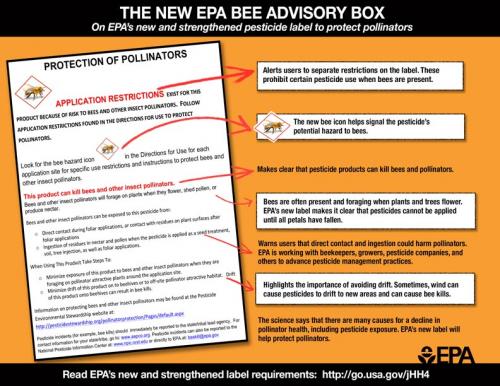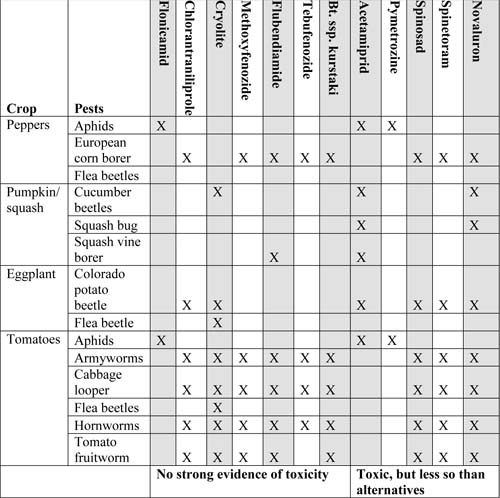New labels restrict use of select neonicotinoids in vegetables to protect pollinators
New labels for neonicotinoids that can be applied in fruiting vegetables will restrict their use patterns to protect pollinators.
The Environmental Protection Agency (EPA) is requiring labels of select neonicotinoid insecticides to include new restrictions to protect honey bees and other pollinators. Specifically, all insecticides which can be applied as outdoor foliar sprays and contain the active ingredients chlothianidin, dinotefuran, imidacloprid or thiamethoxam will contain warning icons and directions for use to minimize impact on pollinators. These will be relevant to use of these products in fruiting vegetables such as eggplant, peppers, tomatoes, squash and pumpkins.
Importantly, neonicotinoids are just one class of insecticides that can impact pollinators. Like all insecticides, wise use can reduce negative impacts while helping achieve pest management goals. Other insecticides could have a similar effect on pollinators, and simply switching to another chemistry may not protect bees. The important thing to remember is to follow the label directions, and these are changing for labels of products that pose a risk to bees.
The label changes will have two main parts. First, there will be a Pollinator Protection Box immediately below the Environmental Hazards section.

A pollinator protection box alerts users to label restrictions that protect pollinators, highlight the new bee hazard icon, summarizes how bees can be exposed to neonicotinoids, and gives basic precautions you can take to conserve pollinators. Click on image to download a printable/larger version.
Second, specific use restrictions are placed in the “Directions for Use section.” Restrictions are as follows. For crops where the grower is contracting with a beekeeper, applicators should either not apply the product until flowering is complete and all petals have fallen, or notify beekeepers at least 48 hours prior to application of the insecticide. For flowering crops where contracted beehives are not used, the products can be applied if one of the following conditions is met:
- Bloom is over and all petals have fallen.
- The application is made after sunset.
- The application is made when temperatures are less than 55 degrees Fahrenheit.
- The application is made in accordance with a state-administered apiary registry program, where beekeepers in the area are notified at least 48 hours in advance of application.
- The pest population is documented as being above a pre-determined threshold and beekeepers in the area are notified within 48 hours of application.
These are paraphrased from the full EPA text. Note, in interpreting this, it is useful to know roughly how far honey bees can travel. Research in European farmland found evidence that honeybees on average forage 1 mile from their hives, but may travel up to 6 miles. So, they could move into treated fields from hives over 1 mile away to be affected by applications. Effects would likely be greatest on hives within 1 mile of treated fields and decline for hives further away, as fewer and fewer bees will reach treated areas from distant locations. Michigan State University Extension suggests that you talk to your beekeeper and perhaps also contact a Michigan beekeeping club to find a local commercial beekeeper that is willing to have an open discussion with you about the logistics of maintaining a bee-safe pollination period. You both have a vested interest in their survival.
Products and pests affected
Fruiting vegetable crops including eggplant, peppers, tomatoes, pumpkin and squash crops may be attacked by pests during the period when they are flowering and attracting bees. At least 11 products containing chlothianidin, dinotefuran, imidacloprid or thiomethoxam can be used in foliar applications to protect these crops against insect pests. Five products – Leverage, Brigadier, Swagger, Voliam Flexi and Endigo – are combinations of other active ingredients and a neonicotinoid. These combination products are labelled for a broad range of pests, as most combine a broad-spectrum contact-poison like pyrethroids with neonicotinoids. For example, Endigo ZC is labelled for use against nine pests in tomatoes, pumpkins and squash. However, many of the pests for which these are labelled include insects that are only periodically important.
Products which will include use restrictions to protect pollinators, and the number of pests they are labelled for in eggplant, peppers, tomatoes, pumpkins and squash.
|
Common name of a.i. |
Product |
Eggplant |
Peppers |
Tomatoes |
Pumpkins |
Squash |
|
Chlothianidin |
Belay |
3 |
3 |
4 |
5 |
5 |
|
Dinotefuran |
Scorpion |
2 |
2 |
5 |
5 |
4 |
|
Dinotefuran |
Venom |
2 |
1 |
5 |
4 |
4 |
|
Imidacloprid |
Admire Pro |
2 |
2 |
4 |
0 |
0 |
|
Imidacloprid |
Nuprid 1.6F |
2 |
2 |
4 |
0 |
0 |
|
Imidacloprid + beta-cyfluthrin |
Leverage 360 |
4 |
4 |
9 |
0 |
0 |
|
Imidacloprid + bifenthrin |
Brigadier |
4 |
4 |
6 |
0 |
0 |
|
Imidacloprid + bifenthrin |
Swagger |
4 |
5 |
7 |
0 |
0 |
|
Thiamethoxam |
Actara |
3 |
3 |
5 |
2 |
2 |
|
Thiamethoxam + chlorantraniliprole |
Voliam Flexi |
3 |
3 |
8 |
2 |
2 |
|
Thiamethoxam + lambda-cyhalothrin |
Endigo ZC |
4 |
4 |
9 |
9 |
9 |
There are a number of key pest species on the labels of products that will have restrictions to protect pollinators. Notable pests include aphids in peppers, squash bugs in pumpkins and squash, Colorado potato beetles in eggplants and tomato fruitworms in tomatoes. Non-neonicotinoid insecticides labeled for use against these pests are available and should be used with caution. Although they may not have the same systemic activity as neonicotinoids, they may have high contact toxicity for bees. Check the label for restrictions. During bloom, consider choosing those products with low relative toxicity to bees. There are also good general practices you can use to minimize impacts on pollinators.
Insect pests that are typically present in peppers, squash, pumpkins, eggplant and tomatoes each year and are included on labels of neonicotinoids subject to new pollinator use restrictions, and the least toxic alternative active ingredients with formulations labeled for each pest. Toxicity information was obtained from Pacific Northwest Extension Publication 591. Use all products according to their labels. Information on toxicity to bees could change with new research. The table below does not indicate efficacy for pest control.

Download a printable, larger version of this table.
Dr. Szendrei’s work is funded in part by MSU’s AgBioResearch.



 Print
Print Email
Email




